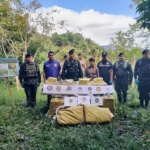CHIANG MAI – On Thursday, at Green Lake Resort in Chiang Mai Province, the Northern Border Narcotics, Precursors and Chemicals Suppression Command held a meeting to drive forward the operational plan for narcotics, precursors, and chemical suppression in urgent areas along the northern border for the 2026 fiscal year.
Lieutenant General Worathep Boonya, Third Army Area Commander, in his role as Commander of the Northern Border Narcotics, Precursors and Chemicals Suppression Command (Commander, NBOC 35), chaired the meeting.
Participants included executives, unit heads, and operational officers from agencies under the NBOC 35 framework. These comprised the Office of the Narcotics Control Board Region 5 and Region 6, the ONCB Mekong Cooperation Coordination Office, ONCB headquarters, Provincial Police Regions 5 and 6, the Narcotics Suppression Bureau, Border Patrol Police Region 3, Pha Muang Task Force, Naresuan Task Force, Internal Security Operations Command Region 3, the Mekong Riverine Unit (Chiang Rai sector), the Border Affairs Department of the Royal Thai Armed Forces, governors and administrative representatives from the six northern border provinces, the Office of the Attorney General Region 5, Customs Office Region 3 and the Department of East Asian Affairs.
On 31 October 2025, the ONCB Board announced the designation of urgent areas for narcotics prevention and suppression for the 2026 fiscal year. For the northern border, six provinces and twenty-five districts were defined as priority zones as follows.
-
Chiang Mai Province
- Mae Ai District
- Fang District
- Chiang Dao District
- Wiang Haeng District
- Chai Prakan District
- Mae Taeng District
-
Chiang Rai Province
- Mae Chan District
- Mae Fa Luang District
- Mae Sai District
- Chiang Saen District
- Chiang Khong District
- Wiang Kaen District
- Thoeng District
- Mueang Chiang Rai District
-
Mae Hong Son Province
- Pai District
- Pang Mapha District
- Mueang Mae Hong Son District
-
Phayao Province
- Phu Sang District
- Chiang Kham District
- Nan Province
- Chaloem Phra Kiat District
-
Tak Province
- Umphang District
- Phop Phra District
- Mae Sot District
- Mae Ramat District
- Tha Song Yang District
These areas expand on those listed in the previous fiscal year so that narcotics, precursors, and chemical suppression can cover a wider and more sensitive border zone. For the 2026 fiscal year, NBOC 35 has already completed a joint operational plan.
The meeting aimed to brief all operational units on this plan, the performance indicators, and the practical approach for implementation. The focus is to create clear benefits for every agency, especially in terms of integrated work and cooperation across units, so operations in the 2026 fiscal year become more effective and better coordinated.
Lieutenant General Worathep Boonya officially launched the NBOC 35 Operational Plan for the 2026 fiscal year during the meeting. He outlined the main priorities for the year, noting that operations will be stepped up and made more intensive. A key part of this approach is stronger intelligence work to identify drug production sites, support international coordination, and secure support to destroy those production facilities.
He also highlighted the need to expand arrests to target major traffickers and to seize and freeze related assets, to weaken the financial base and structure of trafficking networks. At the same time, the command will continue to strengthen communities along the border by using local mechanisms such as village security units.
These village groups play a role in community surveillance and reporting suspicious activities to state officials, while provincial and district authorities will support monitoring in high-risk areas.
From 1 October to 15 November 2025, NBOC 35 reported significant operational results under its five functional components: command, administration, interdiction, suppression and follow-up, and prevention.
During this period, there were 38 key incidents. These included 10 armed clashes with drug smuggling groups and 28 seizure and arrest operations. Authorities handled 32 major narcotics cases.
Seizures in this time frame included:
- 73.74 million methamphetamine tablets
- 1,447 kilograms of crystal methamphetamine (ice)
- 155 kilograms of ketamine
- 61 kilograms of heroin
- Asset seizures and freezes worth more than 46 million baht
When compared with the same period in the previous year, arrests and seizures have risen. This increase reflects the strong commitment and improving performance of officials in intercepting, preventing, and solving narcotics problems in a concrete and measurable way.















